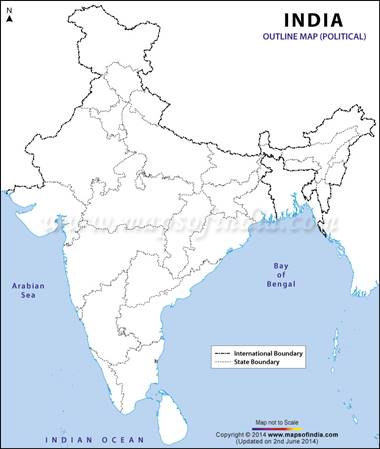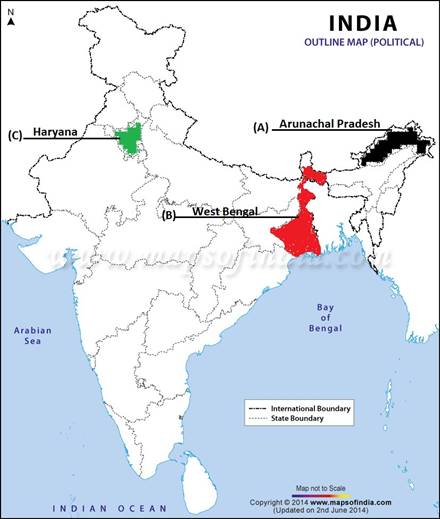Population - Test Papers
CBSE TEST PAPER-01
Class –IX Social Science (Population)
General Instruction:
- All Questions are Compulsory.
- Question No. 1 to 4 carry one mark each.
- Question No. 5 to 10 carry three marks each.
- Question No. 11 and 12 carry five marks each.
- What was India’s population on March 2001?(Census 2001)
- Which is the most populated state in India?
- What is the density of population in India?(Census 2001)
- Which Indian state has the highest density of population?
- How would you summarize the problems faced by the poor population of India?
- Identify the different problems faced by the Adolescent population of India?
- Why is the Northern Indian Plain thickly populated? Mention the two states of Northern Plains with high population density.
- Name the areas where moderate densities of the population are found and elaborate the reasons of their moderate densities of population.
- Why is the population vital element of study?
- On the political map locate and label the following
- A state having population density 100 and below
- A state having population density 501 and above
- A state having the lowest sex ratio

- Describe of distribution of Population in India?
- Which process of the population is responsible for distribution and composition population? Explain its types also.
CBSE TEST PAPER-01
Class –IX Social Science (Population)
[ANSWERS]
- 1028 million
- Uttar Pradesh
- 324 persons per sq km.
- West Bengal
- In spite of many considerable achievements, the health situation is a matter of major concern for India.
- The consumption of calories per capita is much below the recommended levels.
- A large percentage of our population is afflicted by malnutrition.
- The availability of safe drinking water and basic sanitation amenities are to be availed to only one-third of the rural population.
- The adolescents require more nutrition than normal child or adult. Poor nutrition can lead to deficiency and stunted growth.
- The diet available for Indian adolescents is not sufficient in all nutrients.
- Anemia is common in most of the adolescent girls in India.
- Their problems have so far not received adequate attention in the process of development. They have to be sensitized to the problems they confront.
- The Northern plains of India are thickly populated because it is agriculturally very productive.
- The high productivity is because of the deposit of fertile alluvial soil across the plain, adequate water supply for agriculture due to the presence of many rivers and favourable climate.The northern plain and the delta regions have fertile soils. As such, these areas are very thickly populated.
- Climatic conditions: Areas of Northern Plains receives heavy rainfall. It is over about 400 cm of rainfall annually.
- Economic activity: Agriculture and animal rearing can be done throughout the year. Plains terrain allows better means of transportation through road and railways and waterways.
- West Bengal, Bihar Uttar Pradesh is the most populous states of this region.
- The moderate population densities are found in Assam and most of the peninsular states. The following are the factors influence the population densities in these states:
- Hilly, dissected and rocky nature of the terrain.
- Moderate to low temperature.
- Shallow and less fertile
- The people are important to develop the economy and society. The people make and use resources and are themselves resources with varying quality.
- The population is the key point from which all other elements, like, human resources, calamities, disasters are all meaningful and are observed to arrive significance and meaning.
- It is represented by numbers, distribution, growth etc, to provide the basic background for understanding all aspects of the environment.
- The census of India provides us data and information about the population of a country.
- Hence population is the pivotal element in social studies.

- The distribution of the population in India depends on mainly physical features, climate conditions, means of communication, development of agriculture and industries etc.
- India is primarily an agricultural country and more than 70% percent of the people living in India depend on agriculture. As agriculture is the main occupation of 82% of the Indian people lives in rural areas.
- The coastal plains and the Ganga plain where facilities for agriculture are quite excellent because of level land, fertile soil and suitable climate are very thickly populated areas.
- East U.P., North Bihar and West Bengal which form the major part of the Ganga plain have a very high density of population. The average density of population in West Bengal is 904 km2 and that in Kerala is 819/km 2.
- People in India do not find easy means of earning a living in the mountains, deserts, and plateaus. The mountain regions of the north have, therefore, a very low density of population. In Rajasthan, desert density is also very low.
- Large areas of the plateau regions are also unsuitable for human habitation.
- Migration is the process of population growth which is responsible for the composition and distribution of the population.
- Migration is the third component of population growth and change. Migration is the movement of people across regions and territories. It can be internal and International.
- Internal migration is the movement of people with in the country and the international migration is the movement of the people between the countries.
- Internal migration influences the distribution of population within the nation, but it does not change the size of the population.
- Change in the composition and distribution of population takes place due to migration.
